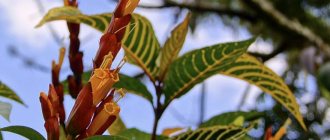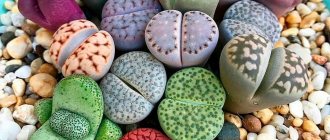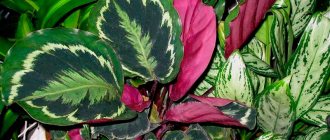Reproduction
In fact, ficus benjamina can be propagated in various ways: using seeds and vegetatively. But in practice, the plant is most often divided by cuttings after spring pruning. Although you can cut and plant cuttings all year round, it’s just in the spring that they take root and grow much faster.
How to prepare a cutting? Cut off the top of the ficus using sharp scissors or a knife. The length of the cutting should be approximately 10-12 cm. Do not touch the upper leaves on it, but you can remove a couple of the lower ones. While the cut is fresh and juice is released from it, the cutting should be placed in the ground or in water so that it takes root. And when the root system of the plant gets stronger, it can be transplanted into the ground. You need to prepare the soil in the same way as for replanting.
Selection of capacity
To replant a ficus, you should use a ceramic or clay pot. However, the new container should not be excessively large; it is advisable to choose a container slightly larger than the old pot. In this case, optimal adaptation conditions will be created for the root system.
How to care for ficus benjamina
Actions for caring for Ficus Benjamin should become automated. There is nothing complicated; caring for a tree is not only simple, but also interesting.
Proper care gives the plant the opportunity to show its best side.
Location in the house
Good lighting - yes, direct sunlight - definitely no. Try to choose a place where there will be an abundance of diffused light. Such lighting is usually located near western or eastern windows. If your windows face south, then leave the ficus a little to the side or consider shading during the midday hours. North windows will have a lack of lighting.
Lighting and temperature
In summer, ficus prefers from +18 to +23°C, and in winter +16°C is enough, but the temperature should not drop below. Wintering at room temperature is suitable. In the warm season, the plant loves fresh air. In summer, the tree is taken out onto the balcony, protected from the wind.
Air humidity
After direct sunlight, this will be the second “no” that the ficus will tell you - no dry air! Here you should focus on the natural conditions of the tree, where there is high humidity all year round.
The humidity around the plant can be increased by any available means; regular spraying of the leaves will also work well.
How to water correctly
Watering in summer should be more abundant than in winter. But there is no need to flood the plant, otherwise you will get root rot and lead to the death of the tree. It is enough to water 2-3 times, allowing the top layer of the substrate to dry.
What soil is needed for ficus benjamina?
Select the soil for ficus benjamina so that the combination of deciduous soil, turf, coarse sand and peat is in proportions 2:2:1:1. It is good to add charcoal to the peat layer. You can purchase ready-made substrate for ficus.
How to feed ficus benjamina at home
Your tree needs feeding from spring to late autumn. A complex mineral fertilizer for Ficus Benjamin is suitable for this, which needs to be fed to the plant once every two weeks. In winter, ficus is fertilized once every 1-1.5 months.
Trimming and shaping the crown and stems of Ficus Benjamin
Although it is recommended to plant 2-3 plants in one pot at once, nothing bad will happen if your ficus grows in one trunk. Before you start shaping the crown, you should know when to start pruning your Ficus Benjamin. A tree that needs pruning has elongated, poorly leafed branches. You should not bring the ficus to this state. We will tell you how to properly trim ficus benjamina.
Examine the tree. Select the longest branches and shorten them with sharp scissors, removing the tip with 2-3 buds. This procedure is carried out in the warm season before the next feeding. All cuts are sprinkled with charcoal, as the plant exudes milky juice.
Braiding stems
Look how beautifully the ficus trees are woven into a braid. This is a good answer to the question of how to form Ficus Benjamin at home - you need to immediately plant 3 plants side by side and gradually weave them into a braid. The bark that touches the stems is cut, and the trees grow together. You can go the other way: use a braid to braid a cylindrical object, which is then taken out.
Compositions in bonsai style
Growing an indoor ficus bonsai is the easiest way to obtain such an interesting plant shape. Select a flat, elongated container into which a small ficus is planted. Wire and weights serve as clamps for bending branches. After six months, the load can be removed and the branches turned in a different direction. All types of bonsai require abundant feeding.
Please note that bonsai is an art, and your ficus will take many years to turn into a magnificent tiny tree
Lighting
The plant is quite light-loving. If the variety has monochromatic leaves, then it is better to place them in semi-shaded areas, and if there are light leaves, they should be placed in diffused light.
If there are variegated leaves, it is advisable to leave them in well-lit areas of the house, for example a wide windowsill with a south-east window orientation. Only plain ficus trees can be placed on window sills on the north side, and even then in the summer.
In the autumn-winter period, additional lighting will be required. If the flower is placed on the south side, then in summer it is important to avoid the midday sun, which will severely burn the leaves.
Experts advise immediately finding a permanent location for the ficus. In the process of growth, he tries to adapt, adjusting to the daily routine and adjusting metabolic processes. If you rearrange the flower, difficulties may arise.
The plant needs direct sunlight in the morning before 11 a.m. and in the evening after 5 p.m. To protect from the midday sun, it is advisable to leave a light curtain on the window. In the autumn-winter period, flowers move closer to the sun.
Ficus care: propagation, fertilization and replanting
Reproduction
Ficus benjamina - caring for the plant at home begins with its propagation. The best propagation option is cuttings. If the cutting is placed in water or soil for 4 weeks, new roots will appear on it.
An important condition when placing a cutting in water is to replace it periodically (once a week). If the cutting was planted in the ground, then for better absorption it should be covered with a jar to create a greenhouse effect
In order for new roots to appear on the cuttings, before planting it in the ground, you should dip it in warm water with sugar.
Suitable seasons for plant propagation are spring and early summer, that is, from April to June. After all, it is during these months that the active development of the root and foliage systems occurs, respectively. The cuttings that are cut for replanting should have several nodes with leaves.
Ficus can also be propagated using leaves. This option is much more complicated and time-consuming, but it is used if necessary. In this case, the lowest leaf is cut off and placed in water.
To avoid the formation of rot on the leaf, add an activated carbon tablet or acetylsalicylic acid to the water.
It will take a long time for the roots to appear on the leaf: from 2 to 3 months, so it is important to change the water. The leaf can take root with the help of soil, but it is necessary to provide it with normal conditions in the form of observing the parameters of temperature, lighting and humidity
Transfer
Reasons for replanting Ficus Benjamin:
- The pot became small.
- It is necessary to add bait to the soil, replace it and improve the drainage system.
- If the roots are wrapped in an earthen lump.
- If you need to propagate the plant.
Ficus benjamina - home care includes replanting annual flowers once a year. If the ficus is already more than 5 years old, then you can replant it once every 3 years. To replant a plant, you first need to select a pot.
It should be small and not smaller than the previous one. You should take a pot that is slightly larger than the previous one (3-4 cm). Initially, drainage is placed at the bottom of the new pot. To do this, you can use pebbles or foam.
When a ficus is transplanted, it is imperative to avoid deformation of the root system during the process. To avoid its damage, the ficus is transplanted using the transshipment method. This means that the plant along with the soil is removed from a small pot and, without removing the soil, it is placed in a new pot. The missing soil in the pot is replenished with leaf soil or universal soils.
Even if the pot in which the plant grows is small, you should wait for the specified period and then begin replanting. The specified time is necessary for the assimilation of the plant in a new room with a certain microclimate, humidity, temperature and light.
Fertilizer
Ficus benjamina means feeding it. Flower feeding is carried out mainly in summer and spring once every 2 weeks. The following universal fertilizers from the following manufacturers are used as fertilizer:
- Bona Forte;
- Reasil;
- Pokon.
In spring and summer, the plant is in the active growing season, so it is important to provide proper feeding. In winter, the plant does not need bait, especially if there is no additional lighting
DIY ficus benjamina bonsai. How to create a bonsai at home from ficus benjamina
The tradition of growing bonsai garden trees has come to us from time immemorial. The art of creating mini plants has been honed to perfection over many years. Today, a new product has appeared in this direction - growing bonsai among indoor trees. Considering the options, flower growers agree that ficus benjamina bonsai is the most successful solution that exists. The Benjamin variety has all the necessary characteristics to create a dwarf tree with your own hands:
- Small leaves, which will largely create a “dwarfing” effect;
- Beautiful ficus bark, this creates additional beauty of the plant;
- Presence of branched roots;
- The plant grows quickly - you can grow a bonsai with your own hands in 2 years.
Before making a bonsai, you should carefully consider the shape of the future plant.
What are the different forms of bonsai (for indoor ficus plants)
There are several common forms:
- Tekkan or upright. It is better to grow your first bonsai with your own hands in this classic form. This species is characterized by a straight, thick trunk, a widely branched root system, the branches become smaller towards the top. This bonsai looks like a classic pyramidal tree, only in miniature size.
- Moyogi or incorrectly standing. This type differs from the previous one only in that its trunk bends in one or more places.
- Shakan or twisted. It is characterized by everted roots, on the one hand, and a strong slope of the branches on the other.
- Sokan or double. A feature of this species is the bifurcation of one trunk, with one root system. The appearance of this bonsai, which is below in the photo, gives the impression that one trunk is the parent and the other is the child.
- Hokidachi or broom-shaped structure. The appearance of this ficus is similar to a broom, although outwardly it gives the impression of a simple form, but in reality it is not. This type is considered one of the most complex designs and requires a certain skill from the grower.
- Esueue or forest grove. A characteristic feature of this species is the simultaneous planting of ficuses of different types and ages in one container or pot, which creates the effect of a forest.
Any master class on growing bonsai takes place according to the following scheme:
- Modeling of trunk and branches;
- Formation of the root system.
Master class on giving the desired shape to a ficus
The creation of a bonsai consists of the formation of:
- Roots;
- trunk;
- Crowns.
Roots
To achieve the desired appearance of a bonsai, the ficus is planted in a spacious container or pot filled with plenty of drainage. And to create a widely branched root system, you need to regularly pinch the top of the plant. With regular pinching off of the top bud, the ficus grows in width, and the roots also grow at the same time. To create the effect of roots coming out (look at the photo below), it is necessary to trim the root system every six months and replant it in a wider pot. When replanting the pot, you need to lift the roots a little higher so that they eventually end up above the drainage surface.
Crown
You can grow a bonsai of the desired shape with your own hands by regularly trimming excess branches and pinching the top bud. Ficus is a fast-growing plant and will require very little recovery time. The general scheme is as follows: for every 8 sheets grown, cut off 4, etc. After pruning, the cut areas will begin to secrete milky juice, which is called latex. You should start circumcision from the bottom, gradually moving up step by step, to the very top of the head. When carrying out the procedure, it is necessary to use a special sharp tool (garden shears, sicator, razor, knife), and after all manipulations, lubricate the cut areas with crushed charcoal.
“Florists, when conducting a master class, recommend using miniature tools and never cutting off foliage, only branches and roots.”
After cutting the ficus leaves, they begin to turn yellow, curl, take on rigid shapes, and the overall appearance deteriorates greatly. The main pruning should be done in early spring, when the plant is in the stage of rapid growth, if necessary in summer or early autumn. It is strictly forbidden to carry out any manipulations in the summer; at this time, ficus plants are “hibernating” and all life processes slow down.
Trunk
To give the desired shape and length to the trunk, use 2 methods:
- Tying. With this method, the top or branch is tied to the base, thereby creating the desired, often curved appearance.
- Use of wire structure. In order to grow a bonsai of the desired shape, insulated wire is used. You cannot use this method immediately after pruning, as the tree may be deformed. You cannot wrap the wire too tightly around the trunk and branches; there is a danger that you will drag out the natural life processes of the plant, and it will begin to dry out. It is better to wrap a bonsai starting from the roots, gradually moving along the trunk and smoothly moving to the crown. After wire fastening, you should not touch the ficus for at least 7-8 weeks, after which you can carefully remove the structure. During this time, the plant will independently learn to maintain the proposed shape and does not require further intervention. When removing the wire, you should not unwind it, only cut it, in order to avoid breaking the necessary branches.
Necessary Requirements for Successful Bonsai Growth
Location
Ficus can be kept outdoors all year round, provided the climate is warm enough; it is worth remembering that the plant is tropical - it loves light and water. It is strictly forbidden to keep bonsai in a draft or in a cold, changeable climate. For successful plant growth, it is necessary to provide good temperature conditions, without changes. In extreme heat, it is better to hide the ficus indoors or in a cool place; the leaves may turn yellow from exposure to intense sunlight.
Watering
Bonsai is grown at home in small pots filled with drainage. Watering should be done more often than usual, as the drainage dries out faster than the soil. In order to grow a bonsai with your own hands, you need to water it daily, but in small doses. The use of aerosol spray bottles can make feeding easier in the hottest and driest weather. You need to spray the leaves, roots and trunk every day.
Feeding
Due to abundant and frequent watering, all the nutrients in the drainage are washed out very quickly. Therefore, it is almost impossible to grow a beautiful and healthy bonsai without additional nutrition. It is necessary to start feeding in the spring, during the active growing season. You need to use liquid organic fertilizers. You need to feed approximately once every 2 weeks or less. In winter - once a month. After using additional “food”, your ficus will begin to grow 2 or 3 times faster and recover faster after pruning.
Important: In case. If your bonsai begins to shed its leaves, as in the photo below - most likely there is severe humidity or dryness, you need to start ventilating the room. Check the condition of the roots for rotting or dryness. If there are overdried roots, you need to start watering; if they are rotting, on the contrary, reduce the intensity and frequency of watering. Provide good lighting in the room and completely eliminate the possibility of drafts.
Trimming and shaping the trunk of Ficus Benjamin
How to form ficus benjamina photo
Sanitary pruning must be carried out, the rest is at your discretion. In the first weeks of March, trim off bare, dry and out-of-shape branches. “Cutting” will not only improve the appearance of the plant, but will also awaken the buds of new shoots.
Ficus benjamina is of interest to flower growers and phyto-designers due to the opportunity to show their creative abilities.
- The formation of the trunk must be carried out immediately, while the young shoots are bending well.
- To do this, plant several cuttings in one container.
- Intertwine them with each other as you wish.
- In order for them to get used to the new position, the stems should be secured in places of contact with threads or wire.
- Bandage without unnecessary tightening.
- As they grow, they will take on the desired shape: braid, lattice, spiral, vase.
- To form something like a vase, you need to plant the cuttings around a cylindrical tube (you can use a plastic bottle). When the stems become coarse, the clamps can be removed.
Forming a bonsai from ficus benjamina is another great way to give a non-standard look to a plant.
When carrying out any pruning, adhere to three key principles:
- Use a disinfected instrument (scalpel, fire-heated knife);
- Make the cut above the growth bud;
- If the shoot is thick, make the cut not straight, but at an angle of 45 °.
Diseases
Plant diseases can be caused by non-compliance with care rules due to:
- lack or excess of watering;
- temperature disturbances;
- improper lighting;
- Excessive fertilizer application or lack thereof.
Florists may have several problems. In particular, the question is often asked why ficus Benjamina sheds its leaves and what to do in this case.
Usually the lower leaves fall off as the flower matures. This is a natural process, although it is advisable to study the conditions of detention - at excessively low or high temperatures, this effect can also occur.
Other known problems:
- Withering leaves begin to curl - this is evidence of hypothermia of the ficus.
- The ends of the leaves turn brown. The reason is very low humidity or dry air.
- Excessively thin shoots appear if the flower lacks light.
- The leaves of Ficus benjamina may turn yellow if the plant is watered too frequently, causing the roots to rot.
- The excessively soft structure of the leaves is a consequence of hypothermia.
- The appearance of yellow or brown spots is caused by sunburn of the leaves and excess lighting.
At the same time, there are more dangerous diseases caused by specific factors:
- botrytis - the formation of a whitish coating on the leaves;
- cercospora - dark blotches at the back of the leaf followed by wilting;
- anthracnose - dryness of the edges of the leaves with the appearance of brown spots.
If these problems appear, then the infected parts are removed from the plant, and the entire flower is quarantined and treated with a fungicide.
Conditions for growing Ficus Benjamin
Ficus benjamina in the interior photo
Illumination
Like most plants taken for growing at home from the tropics, Ficus Benjamin needs bright light and moderately warm air temperatures.
It is photophilous; variegated forms (with variegated leaf colors) need especially good lighting. Direct sunlight, as well as insufficient lighting, negatively affect the condition of the plant. Thus, the sun can leave burns on the leaves, and when grown in the shade, growth rates slow down and the plant looks depressed. For comfortable growth and development, provide bright, diffused lighting. The most suitable place for placing Ficus Benjamin is near a window (on the windowsill), a balcony facing east or west.
Air and ventilation temperature
Ficus Benjamin adapts perfectly to room temperature, which is comfortable for humans. Ideally, during the warm season, maintain the temperature within 18-25 °C (the plant “does not like heat and stuffiness,” just like us). With the onset of winter, the temperature should not fall below 16 °C.
It is better to spend the warm season of the Benjamin ficus outdoors (balcony, garden, veranda, gazebo), this promotes normal growth and tillering. Choose a secluded place: out of the reach of precipitation and strong gusts of wind, avoid direct sunlight.
Ventilate the room regularly, but avoid placing the plant in a draft or directly exposing it to cold air.
General description of the plant
Ficus benjamina is a small-leaved shrub belonging to the Mulberry family. This plant, which is extremely popular among gardeners, received its name in honor of the botanist J. Benjamin Daydon. The ficus is native to the South Asian region, which is why it is unpretentious in maintenance and care.
The most problematic period for a plant is the first 3 months. growth in a new place. If the outcome is favorable, when the flower takes root during this time, in the future it will require a minimum of attention.
In its natural environment, the plant grows in the Philippines, India and Malaysia, as well as in Southern China and Northern Australia. The size of the flower may vary depending on the varietal specifics and requirements for its content.
Some of the plants do not grow higher than 50 cm, but there are varieties that grow up to 3 m, as pictures of Ficus Benjamin clearly demonstrate. Experts call its features:
- indicators of average growth rate up to 20 cm per year;
- lack of flowering when grown at home with the possibility of the appearance of spherical inflorescences similar to berries when kept in greenhouses;
- ease of care.
This perennial has an original pattern on its leaves. Thanks to its appearance, ficus will easily fit into the home interior of both a city apartment and a country house.
Types of Ficus Benjamin
There are several types of Ficus Benjamin. They all differ in the color and shape of the leaves, as well as in their size. We will describe only the most popular of them, and the photos will help you choose the variety that suits your tastes.
Natasha
Variety Natasha belongs to the subvarieties of Benjamin. It is an evergreen multi-leaved shrub, reaching a height of up to two meters in indoor conditions. The branches are densely spaced and densely covered with uniform small leaves. The leaves have a leathery structure, ellipse-shaped with a pointed tip (Figure 2).
Figure 2. Variety Natasha
Representatives of the Natasha variety do not like direct sunlight and drafts. Feels good growing constantly in one place. Needs regular crown shaking and watering.
Anastasia
The Anastasia variety has a variegated color. The center of the leaves is dark green, the edges and central vein are light green. The leaves also have jagged edges. This species can take the form of a tree or shrub, or any other shape that you want and create yourself (Figure 3).
Figure 3. Variety Anastasia
This species is not very demanding in terms of care. The main thing is to place it on a south window so that it receives a lot of light. The air temperature in winter should be no more than +16°C, and in summer +25°C. Doesn't like drafts. Watering is carried out every four days, and the leaves are also regularly sprayed with settled water at room temperature.
Starlight
The main feature of this species is its variegated leaves. Their entire surface is covered with large white or cream spots. Sometimes you can find completely white leaves. They are large, lanceolate-shaped with a narrow tip. The edge of the leaf is slightly wavy (Figure 4).
Figure 4. Representatives of the Starlight species
A representative of the Starlight variety can be formed into any shape. It grows slowly. After purchasing, it is recommended to put it in a bright place where it will always be. Watering should be done moderately, avoiding over-watering.
Lovely
Lovely is a type of evergreen dwarf bushy variety. The height of such a plant is no more than half a meter. The leaves are variegated in color, elongated, about five centimeters. They are slightly wavy along the edges.
The Lovely variety loves a lot of light, but does not tolerate direct sunlight. In summer it needs abundant watering; with the arrival of winter, watering is reduced. Loves spraying and high humidity, does not tolerate drafts and excessive watering.
Mix
The leaves come in two types: variegated and plain dark green. The permanent location of the plant depends on the color of the leaves. Plants with variegated leaves love light more, so it can be placed on the south side. And a specimen with dark green leaves feels better on the eastern side, where the light is diffused, perhaps even partial shade.
This species is very attached to its owners, and your short absence can lead to “baldness” of the plant.
Special attention should be paid to watering. It is carried out with settled water once or twice a week.
In winter, once every two weeks. Avoid overwatering and protect the plant from drafts.
Daniel
The appearance of the Daniel culture resembles a small tree with succulent leaves of a rich green color. Its height can reach two meters (Figure 5).
Figure 5. Variety Daniel
Such a tree needs a lot of light, but it is better to avoid direct rays. It is better to use bright and diffused lighting. To do this, it is better to place it near the southeast or southwest window. In summer it is better to take it out onto the balcony, but provide protection from the sun. The optimal temperature for the plant is not lower than +20°C. If the temperature drops to +15°C, the ground should be covered with plastic film. Watering is carried out once or twice a week, in winter it is reduced to once.
Kinky
Kinki is a dwarf variety. It differs in the size and color of the leaves. They are narrow and small, variegated, light green in color, edged with a salad or cream edge. The branches are drooping, the stem is erect, woody (Figure 6).
Figure 6. Representatives of the Kinki species
Kinky should be kept in a bright room, away from direct sunlight. In winter, the plant should be placed away from heating devices and radiators. For a comfortable stay of the plant, the air temperature should not be lower than +15°C.
After purchasing a pot with a plant, it is better to immediately place it in a certain place, since rearranging it is unnecessary stress. Water moderately, avoiding waterlogging, as stagnation of moisture can cause root rot and the plant will die.
Popular varieties
The plant has a wide variety of varieties, so anyone can choose the best option that suits them in appearance and in terms of combination with the interior of the room.
You can verify this by looking at the photo of the ficus benjamina flower:
- Exotic - a variety that is decorated with dark green leaves with wavy edges. Compact
- Daniel - has large leaves up to 6 cm of the same shade as the previous variety.
- Monique is a popular variety among gardeners. There are two options - Monique and Golden Monique. A distinctive feature is the presence of a golden hue. At the same time, the variety is more demanding in care.
- Reginald is a beautiful plant with variegated leaves. This effect is achieved due to the presence of light green spots on the surface of the leaf. It has leaves with smooth edges.
- Kinki is a variety with an emphasizing light green edging on a darker leaf. Differs in small leaves up to 5 cm. During the care process, it is necessary to regularly trim and shape the flower.
- Nicole - the flower is decorated with leaves with a wide light green edging, which emphasizes the originality of the plant in contrast with the dark background.
- Starlight is a ficus, characterized by almost completely white leaves. The plant requires bright lighting.
- Baroque - the presence of twisted small leaves creates an original look for the flower.
Watering and feeding Ficus Benjamin
Ficus does not tolerate drought, reacting to dry soil by yellowing and falling leaves. On summer days, the plant is watered often and abundantly so that the soil surface almost dries out between waterings.
It is important not to allow moisture to stagnate. Its excess, flowing into the pan, must be removed after half an hour.
If this is not done, even in summer you may encounter manifestations of root rot.
Asking the question: “How to care for Ficus benjamina?” Many novice flower growers forget about such an important stage of care as fertilizing. Ficus grows quite quickly, and in order to maintain the formation of the crown and the succulence of the leaves, it needs not only moisture, but also the entire complex of nutrients and microelements
Therefore, from spring until the beginning of autumn, caring for the Benjamin ficus, in the photo, at home must include regular feeding. It is best to use liquid complex products for decorative foliage crops. Fertilizers are applied at intervals of two weeks.
Features of feeding
Ficus is fed in the spring-autumn period, and the frequency of supplementation will be different. In the period from March to April, feed once every 1 month, and in June, during active growth, you will need to feed up to once every 2 weeks. This regime continues until September. In autumn, the frequency of feeding is reduced to once a month, and in winter it stops completely.
Thanks to nutritious soil, the health of the plant can be improved. They use organic and mineral fertilizers; compost-vegetable compositions are also suitable. Mixtures for fertilizing ficus plants or complex formulations suitable for decorative foliage plants are offered for sale.
Nitrogen-rich fertilizers stimulate the growth of green mass. Foliar feeding is carried out with a spray bottle. For intensive development of new branches, the Epin solution is suitable.
If new leaves turn yellowish, this may be a signal of iron deficiency, and therefore you will need to use a Ferrovit solution.
Caring for Ficus Benjamin
Temperature and lighting
Benjamin's ficus can develop normally only with sufficient lighting. He prefers bright but diffused light. Summer temperatures are highly desirable: moderate, not higher than +25 degrees. If the temperature is higher, then the probability of shedding leaves is very high.
It is not advisable to keep this ficus indoors in the summer; at the slightest opportunity, expose it to fresh air, taking appropriate measures to protect it from drafts and hot sun rays. In winter, cooler conditions (+16-18 degrees) will be favorable for this indoor plant. Keep in mind that variegated forms of Ficus Benjamin are more sensitive to maintenance conditions and more demanding of care. They need a higher temperature, and they also require higher air humidity. They should be sprayed more often with water at room temperature.
This ficus was photographed 7 years ago, after purchase. And this is what it looks like now. Background for other plants
Watering and fertilizers
During the period when the plant is actively growing, it requires abundant and regular watering. The soil should not be allowed to dry out. During the period when the ficus is relatively dormant (winter), watering is reduced to once every 5-7 days. However, with regular watering, you should not get too carried away and not over-moisten the soil, as this can cause root rot. After an hour after watering, be sure to drain the remaining water from the pan.
Ficus is also fed only during the growth period (spring-summer), once every 10-14 days, not more often. As fertilizers, you can use a regular mineral complex or fertilizers for decorative deciduous indoor plants.
Ficus benjamina transplant
Young plants that have not reached 4 years of age are replanted every spring. In the future, the ficus is transplanted as needed. For plants that have grown significantly and replanting them is somewhat problematic, you can simply replace the top layer of soil with fresh one in the spring. Land for ficus benjamina can be easily purchased at any flower shop. For those who do not have such an opportunity or who make the soil mixture themselves, here is the recipe for its preparation: mix equal parts of peat (lowland), leaf soil, sand and add two parts of turf soil.
Trimming
To make the bush more beautiful and develop better, Ficus Benjamin must be pruned regularly. This is a simple procedure; a lush ficus crown can be formed quite easily. If you want to create a tree from a bushing plant, then in the spring, before active development begins, remove all the lower side branches to the height you need, and cut off the top, leaving 2-3 buds. As the ficus grows, trim the ends of the branches regularly. When pruning this plant, milky juice may leak out; sprinkle the sections with sharpened charcoal or activated carbon.
Ficus propagation by cuttings
Ficus benjamina propagates easily. You can take the cuttings remaining after pruning, put them in a glass of water, and when they sprout roots, plant them in the ground. To speed up the root formation process, you can add a stimulant to the water (“Kornevin”, “Heteroauxin”, etc.).
This is what it looked like at the very beginning...
and so - in two months.
This is the most visual method, since we can visually observe the appearance and growth of roots, discarding unsuitable ones. You can do it even simpler - place the plant cuttings immediately in light soil, but in this case, we will not be able to control the rooting process.
Reproduction by rooting in water
The roots actively appear in the spring. The step-by-step instructions are as follows:
Take an opaque glass and fill it halfway with settled water at room temperature. It is important to prevent contact of the lower leaves with moisture.
If you add 0.5 tablets to water. aspirin and 0.5 tab. activated carbon, the risk of rotting can be minimized. Adding 2-3 drops. a composition that stimulates the development of the root system will help improve rooting.
The glass with the cutting should be left in a warm room. Optimum temperature +25 oC. The room should be bright, but it is important to ensure the dispersion of the rays. As the water evaporates, it is advisable to top it up. The roots appear in 2-4 weeks.
After the roots have sprouted, the cuttings are moved to a pot with the desired soil. After this, it is covered with a bag or jar. Thanks to the greenhouse effect, high humidity will be ensured.
The greenhouse must be ventilated periodically.
After 1-2 weeks, a sprout will appear, after which the shelter is removed and the pot is transferred to a permanent place of detention.
Reproduction
Theoretically, the plant can be propagated in different ways: both vegetatively and using seeds. In practice, all types and varieties of Ficus Benjamin are propagated by cuttings, which remain in abundance after spring pruning of the plant. Although cuttings can be cut and rooted all year round, in spring the speed of shoot growth is maximum, and they take root better.
Do it this way. Using a clean tool (knife or pruning shears), cut off the apical shoot from the ficus, at least 10 - 12 cm long. Do not touch the upper leaves, you only need to remove a couple of lower ones, near the cut. When cut, the cutting will secrete droplets of milky juice - they should be blotted with a sterile napkin or rinsed under running water until it stops secreting. If the sap is allowed to harden, it will prevent root formation. Then air dry the cut. Now you can put the cuttings to root in water or directly in the substrate. Let's consider both options.
Rooting in water
Note that in the spring, ficus cuttings form roots more readily than at other times of the year, even in plain water. The procedure here is as follows:
- Place the prepared cuttings in a glass (preferably opaque) with water. The water should be settled, at room temperature, no more than half a glass, so that the lower leaves do not touch the water.
- It is advisable to add half a tablet of aspirin and activated carbon to the water to ensure that the shoot does not rot. If desired, you can add a few drops of some drug that stimulates root formation to the water, for example, Kornevin.
- Place the container with the cutting in a warm place (about 25 degrees), illuminated by the scattered rays of the sun. The water will evaporate - do not forget to add it to the previous level. In two to four weeks, roots should appear.
- When the roots grow a little, transplant the cuttings into a pot with suitable soil, cover it with a bag or jar to create a greenhouse effect with high humidity.
- From time to time, open the greenhouse slightly for ventilation and to accustom the young plant to the temperature of the apartment.
- A guarantee of successful rooting will be the appearance in a week or two of a new sprout next to the transplanted cuttings. Then the cover can be removed and the pot can be moved to the place chosen for it.
Rooting in the substrate
It is believed that the bush obtained in this way grows and develops faster
It is important here that the composition of the substrate is most suitable for Ficus Benjamin: fertile, breathable, with neutral acidity
- Place the cutting in a small pot with drainage and substrate in the center.
- Pour in settled water with the addition of Kornevin or other similar preparations, for example, Gileya.
- Cover the glass with film or another glass on top to create a mini greenhouse.
- Place this greenhouse in a warm place with indirect light for three to five weeks. During this time, roots should appear on the cuttings.
- The cover can be removed. As soon as the sprout begins to grow, we can assume that rooting has been successful.
Soil selection
The best option for ficus will be the soil used when growing plants of decorative foliage varieties. Experienced gardeners often buy soil for mulberry plants or palm trees. Ficus needs a nutrient substrate with neutral acidity. It is advisable to choose a soil that is breathable.
It is also possible to prepare the soil yourself by mixing peat with garden soil and sand in the same combination. It won't hurt to add a small amount of wood ash to prevent acidity.
A dense substrate is more suitable for adult ficus plants, so turf soil with humus is mixed. It is important not to forget about arranging a drainage layer at the bottom. This can be expanded clay or drainage composition with charcoal.
Reproduction of exotics
How does Ficus Benjamin propagate at home? In general, the plant can be propagated in several ways:
- sowing seeds;
- breeding layering;
- leaf cloning;
- planting cuttings.
The best method of propagation is cuttings. The rest are ineffective in apartment conditions. Propagation work using cuttings involves three important stages:
- propagation itself by cuttings;
- rooting cuttings;
- selection of suitable containers.
Cuttings
The stem cutting is taken from an adult healthy specimen. Usually the stems are removed in late spring and summer. At this time, the bush is at its most fluffy and in its prime. Autumn and winter are not suitable for the procedure.
Step-by-step technology
- Propagation by cuttings begins with cutting a small stem. 10-16 cm in length is enough. There should be 6-8 leaves on the branch.
- Cuttings are taken from the top of one of the shoots.
- A disinfected sharp knife is used. Cut at a slight angle.
- The released juice is removed with a napkin. The wound is treated with ash.
- Half of the leaf blades on the stem cuttings are removed.
- The base of the branch is cut into 2-3 parts. Toothpicks and matches are placed between them.
- The twig is placed in a glass of water. Activated carbon is dissolved in water.
- A glass with a twig is placed on the window. Water is added periodically.
Additional Information. After a couple of weeks, characteristic growths will appear at the base of the branch. The roots will emerge from them in another 10-14 days. When the roots reach a length of a couple of centimeters, the cutting can be transplanted into the ground.
The apical cuttings of ficus are germinated in water
To root the shoot, you will need a suitable substrate. You can purchase it at a specialty store or prepare it yourself. Planting takes place in soil consisting of peat, sand, and humus.
Drainage is placed at the bottom of the pot. The container is filled with substrate. A small depression is made into which the cutting is transplanted. The soil is watered. For better rooting, the new plant is covered with film.
For a young bush, you should take a medium-sized, stable pot. It is better if it is made from natural materials. The cutting should not be planted in a large pot. This can cause increased root growth. Because of this, there will be a disruption in the development of culture. The pot should be small in size for the harmonious development of all parts of the plant.
Rooting into the ground
The cutting can be immediately placed in the substrate. Some gardeners are convinced that this option allows you to grow a bush faster. True, the soil must be fertile, neutral acidic and breathable.
And you need to act as follows:
- The cutting is located in a small pot. Drainage must be placed at the bottom. The cutting is left in the center of the container and then covered with substrate.
- Take settled water, add Kornevin or other preparations of a similar effect, and then water the plant.
- Cover to create a greenhouse. An ordinary film or glass jar is suitable for this. Leave the structure in a warm place. The sun's rays should be diffused. Duration – 2-3 weeks until the first roots appear.
- Remove the cover after the specified time. If the plant begins to grow, then all actions have been performed correctly.
Flower growers recommend rooting several petioles in order to be able to choose the healthiest and strongest one.
Recommendations for transplanting refined exotic plants
Experienced gardeners warn that Ficus Benjamin has a delicate root system. It develops in both horizontal and vertical directions. Therefore, replanting a flower is a careful process.
Step-by-step instructions
- A new pot is being selected. It must have drainage holes.
- 24 hours before transplanting, the ficus in the old pot is watered abundantly. This is necessary to make it easier to remove the plant from the tub.
- Before transplanting an exotic plant, drainage is poured into a new pot, then a layer of sand and a nutrient soil mixture.
- The ficus is removed from the old container with a lump of earth. The earth is partially shaken off.
- The root system is placed in a new flowerpot and sprinkled with substrate.
- Exotic will grow better if the plant is watered immediately after planting.
The correct soil for Ficus Benjamin is a fertile substrate. You can purchase a ready-made mixture in the store, enriched with various microelements. You can prepare the soil at home. To do this, mix in equal quantities:
- leaf soil;
- high peat;
- humus;
- mixture of pine needles;
- garden soil;
- turf.
In order to plant a young plant purchased in a store, the substrate is prepared according to a different recipe. Peat, river sand and coniferous soil are mixed. Sand should be less than other ingredients.
Note! It is necessary to replant the ficus every 1-2 years in the spring. A slightly larger pot is selected for him than before
Another reason is unhealthy microflora in the soil. For example, it is too flooded and fungus has grown there.
Transplanting exotic plants is a careful process due to the delicate roots
Periodicity
At home, the flower is replanted in the spring - the most suitable time is March or April. Young ficus trees are replanted annually, and adult flowers - once every 3-4 years. In the process, it is necessary to remove the upper part of the substrate and fill its place with new soil.
To replant, remove the plant from the pot; be sure to leave a lump of earth on the root system. Using the transshipment method, the cutting is placed in the central area of a new container with a laid drainage layer and a layer of new soil. After this, the gaps are filled with substrate. It is advisable to shake the pot periodically.
If the temperature in the room is excessively high, it is advisable to treat the ficus with a spray bottle. But at low temperatures it is advisable to avoid watering for several days. All the features of care can be learned by watching the video.
Features of ficus pruning
Ficus is one of those indoor plants whose shape you can shape yourself. In particular, several plants can be planted in one pot at once, the trunks of which can be intertwined and fixed along the course of the plant, while it would be useful to use additional support. When the tree grows to a more mature age, the clamps can be removed, and it will continue to grow in the direction you set.
You can also shape the shape of the crown of a small ficus tree. To do this, it is recommended to periodically trim its shoots a little, but this can only be done in the spring. Also keep in mind that the stem of the cut branch must still remain long enough, otherwise it may dry out and make the plant very unsightly. Thus, you will get a bush-like ficus, but if you want to form a stamp-shaped tree, just select one strong central shoot and let it grow, while cutting off all the side shoots.
Important! Various pests can also appear on ficus trees, and a regular solution of laundry soap will help you get rid of them. This solution must be periodically sprayed on the plant, and soon all pests will disappear.
Pests
Certain changes in the appearance of the ficus may indicate that it has been attacked by pests. In winter, the plant is not at all protected: it can be attacked by aphids, mites, and scale insects. Improper care will also attract pests. For example, a mite attacks a ficus if it grows in a too dry place. And if the plant is cold or lacks water, it becomes vulnerable to fungal diseases.
And yet, the gardener has reason for optimism - Benjamin's ficus rarely gets sick. Sometimes it can be affected by root rot, but this is only a consequence of improper watering. If you stop the rot at an early stage, the ficus will calmly survive this disease; if you delay, it will die.
You need to fight rot like this: remove the plant from the pot, shake off the soil from its roots, inspect the roots, and cut off the affected ones. After this, you should also trim the crown of the indoor tree. In this case, the cut part of the crown should be proportional to the cut part of the roots. Only after such careful work will Benjamin’s ficus be able to safely develop further. Do not forget that it needs to be transplanted into another container with healthy soil. Watering with a fungicidal solution is also necessary.
Humidity
Along with bright lighting, you should also take care of the humidity in the room. Dry air in the room should not be ignored. In this case, regular spraying will be required, especially in summer. In winter, the frequency of spraying is reduced.
For preventive purposes, it is recommended to periodically treat with aspirin solution - 1 table. for 1 glass of water. At the same time, wipe the leaves.
Regular refreshing showers are carried out as follows:
- The pot is placed in a bathtub or large basin.
- The soil is protected with a film to prevent leaching.
- The crown is watered with a shower. The water should be slightly warm.
After the plant has dried for an hour, it can be returned back to the windowsill.
Note!
Kinusaiga technique - TOP-140 photos of the best ways to create crafts using the Kinusaiga technique with your own hands + instructions for beginners
- Do-it-yourself passe-partout - a master class with step-by-step do-it-yourself schemes. Making tips + photos of the best examples
Decoupage with napkins: TOP-150 photos of ways to decorate with napkins. Simple instructions for beginners at home
In winter, indoor air usually becomes drier due to the use of heating devices. Therefore, you should regularly turn on the air humidifier or treat the ficus with a spray bottle of warm, settled water.











